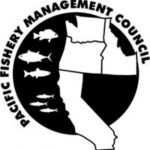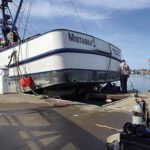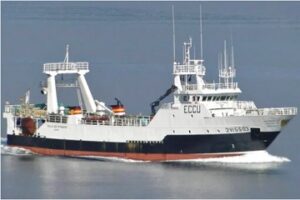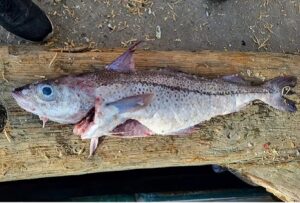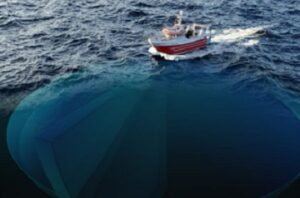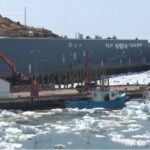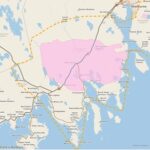Daily Archives: May 19, 2016
Feds Drop Buoy-Napping Case Against Fishermen
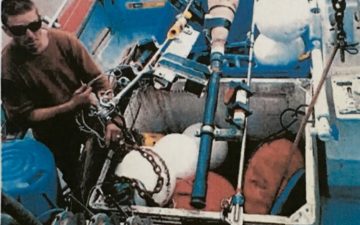 Cooler heads have prevailed, and the feds earlier this week dropped their lawsuit against two fisherman who seized a piece of scientific equipment operated by the United States Geological Survey. A source close to the situation told Courthouse News that the “oceanographic mooring buoy,” known as Scientific Mooring MS, was returned to the United States Geological Survey. The buoy had previously been in the possession of two Moss Landing, California-based fishermen. Daneil Sherer and Patrick Anderson, who run A&S Fisheries, found the piece of equipment in January and demanded $45,000 to return of the equipment. The feds sued the fisherman in late March, accusing them of holding government property “de facto hostage” and causing irreparable harm to an international research project. Read the rest here 20:34
Cooler heads have prevailed, and the feds earlier this week dropped their lawsuit against two fisherman who seized a piece of scientific equipment operated by the United States Geological Survey. A source close to the situation told Courthouse News that the “oceanographic mooring buoy,” known as Scientific Mooring MS, was returned to the United States Geological Survey. The buoy had previously been in the possession of two Moss Landing, California-based fishermen. Daneil Sherer and Patrick Anderson, who run A&S Fisheries, found the piece of equipment in January and demanded $45,000 to return of the equipment. The feds sued the fisherman in late March, accusing them of holding government property “de facto hostage” and causing irreparable harm to an international research project. Read the rest here 20:34
Canada approves genetically modified salmon for sale to public
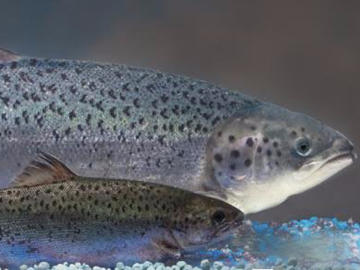 Canadian grocery stores have received the regulatory green light to begin selling fast-growing, genetically modified salmon – the first such species to gain such approval from federal agencies. Health Canada and the Canadian Food Inspection Agency announced Thursday they had completed a scientific review of AquAdvantage’s salmon and it has passed the final regulatory hurdle for the farmed fish. The fish was developed by U.S.-based biotechnology firm AquaBounty Technologies Inc. to promote rapid growth of the fish during early life, using a growth hormone gene from the Chinook salmon in an Atlantic salmon. The company has one facility in Canada, in Bay Fortune, P.E.I., and a production centre in Panama. Dave Conley, a spokesman for the firm, said in an email that it will be a year or more before the firm has any production of market-sized fish. Read the rest here 18:53
Canadian grocery stores have received the regulatory green light to begin selling fast-growing, genetically modified salmon – the first such species to gain such approval from federal agencies. Health Canada and the Canadian Food Inspection Agency announced Thursday they had completed a scientific review of AquAdvantage’s salmon and it has passed the final regulatory hurdle for the farmed fish. The fish was developed by U.S.-based biotechnology firm AquaBounty Technologies Inc. to promote rapid growth of the fish during early life, using a growth hormone gene from the Chinook salmon in an Atlantic salmon. The company has one facility in Canada, in Bay Fortune, P.E.I., and a production centre in Panama. Dave Conley, a spokesman for the firm, said in an email that it will be a year or more before the firm has any production of market-sized fish. Read the rest here 18:53
The first of two towering tidal power turbines to enter Bay of Fundy next month
 The first of two towering turbines designed by Cape Sharp Tidal to harness the immense power of the Bay of Fundy will be installed next month off the coast of Nova Scotia, an company official announced Thursday. Sarah Dawson, the community relations manager for the project, said one of the five-storey high, two-megawatt turbines built in Pictou by Aecon Atlantic Industrial Inc., will be loaded on a barge during the first week of June and travel around the province until it reaches the test site near Parrsboro. That trip will take a couple of weeks. The new turbines are a bigger and more robust version of a turbine tested by OpenHydro and Nova Scotia Power in 2009 that was heavily damaged by the Bay of Fundy’s powerful currents. Read the rest here 18:04
The first of two towering turbines designed by Cape Sharp Tidal to harness the immense power of the Bay of Fundy will be installed next month off the coast of Nova Scotia, an company official announced Thursday. Sarah Dawson, the community relations manager for the project, said one of the five-storey high, two-megawatt turbines built in Pictou by Aecon Atlantic Industrial Inc., will be loaded on a barge during the first week of June and travel around the province until it reaches the test site near Parrsboro. That trip will take a couple of weeks. The new turbines are a bigger and more robust version of a turbine tested by OpenHydro and Nova Scotia Power in 2009 that was heavily damaged by the Bay of Fundy’s powerful currents. Read the rest here 18:04
Can Hag Fish gloop be useful to humans?
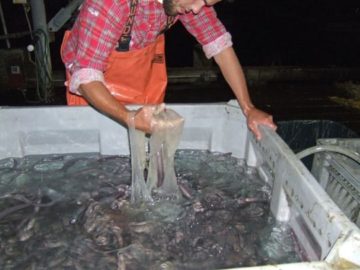 The carrion-eating hagfish has been described as the “vacuum cleaner of the ocean”. But it also has another claim to fame: it can see off its attackers in a puff of slime. Zurich scientists are researching how this fast-forming hydrogel could be harnessed for human use. Jawless and boneless, the hagfish is a rather ugly-looking marine creature that has been around for more than 300 million years. So why are the hagfish of interest to researchers at the lab? The answer is in the creature’s slime. When the hagfish is attacked or stressed it secretes vast amounts of the substance as a defence mechanism – as this shark finds out in this clip. It has to back off or face suffocation. “Hagfish slime is special in many ways,” doctoral student Böni told swissinfo.ch. “It’s the most dilute hydrogel known today. It consists of 99.996% water which is a world record.” Read the article here 13:46
The carrion-eating hagfish has been described as the “vacuum cleaner of the ocean”. But it also has another claim to fame: it can see off its attackers in a puff of slime. Zurich scientists are researching how this fast-forming hydrogel could be harnessed for human use. Jawless and boneless, the hagfish is a rather ugly-looking marine creature that has been around for more than 300 million years. So why are the hagfish of interest to researchers at the lab? The answer is in the creature’s slime. When the hagfish is attacked or stressed it secretes vast amounts of the substance as a defence mechanism – as this shark finds out in this clip. It has to back off or face suffocation. “Hagfish slime is special in many ways,” doctoral student Böni told swissinfo.ch. “It’s the most dilute hydrogel known today. It consists of 99.996% water which is a world record.” Read the article here 13:46
LIFO policy: Newfoundland and Labrador will take a major hit if the inshore shrimp fishery collapses
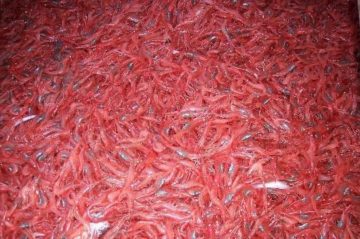 “In 2015, the inshore shrimp fishery contributed $250 million to the economy of rural Newfoundland and Labrador,” Phil Barnes said. “Economic hubs like Gander, Grand Falls-Windsor, Corner Brook and St. John’s all benefit from the inshore fishery. “Inshore harvesters buy vehicles, groceries, fuel, gear and repair services. Plant workers also spend their income at local businesses,” he said. Barnes said the Department of Fisheries and Oceans (DFO) has to scrap its “last in-first out” (LIFO) for the Northern shrimp fishery. “Our inshore fleet has access to one area (Area 6) for a few months of the year while the offshore trawlers are in multiple areas all year round,” he said. “Someone is always there and this has to stop. Read the story here 12:57
“In 2015, the inshore shrimp fishery contributed $250 million to the economy of rural Newfoundland and Labrador,” Phil Barnes said. “Economic hubs like Gander, Grand Falls-Windsor, Corner Brook and St. John’s all benefit from the inshore fishery. “Inshore harvesters buy vehicles, groceries, fuel, gear and repair services. Plant workers also spend their income at local businesses,” he said. Barnes said the Department of Fisheries and Oceans (DFO) has to scrap its “last in-first out” (LIFO) for the Northern shrimp fishery. “Our inshore fleet has access to one area (Area 6) for a few months of the year while the offshore trawlers are in multiple areas all year round,” he said. “Someone is always there and this has to stop. Read the story here 12:57
Fisherman tells Thai court of beer tab that led to years of slavery
 A fisherman from Myanmar described meeting a job broker while having a beer with a friend in the fishing port town of Kantang in southern Thailand. While chatting with the broker, he passed out drunk, without paying for his beer. Four days later, the broker told him he owed her 2,000 baht ($50) for his unpaid beer and his four-day stay in her home, and would have to work to pay off his debt. He ended up enslaved on a fishing boat, working five years without pay, he told a court in Thailand’s southern Trang province as the proceedings began last week in a human trafficking case against nine defendants. The defendants include the broker, as well as the owner of Boonlarp Fishing Co. Ltd., whom prosecutors say is the chief of the trafficking ring. Read the rest here 12:41
A fisherman from Myanmar described meeting a job broker while having a beer with a friend in the fishing port town of Kantang in southern Thailand. While chatting with the broker, he passed out drunk, without paying for his beer. Four days later, the broker told him he owed her 2,000 baht ($50) for his unpaid beer and his four-day stay in her home, and would have to work to pay off his debt. He ended up enslaved on a fishing boat, working five years without pay, he told a court in Thailand’s southern Trang province as the proceedings began last week in a human trafficking case against nine defendants. The defendants include the broker, as well as the owner of Boonlarp Fishing Co. Ltd., whom prosecutors say is the chief of the trafficking ring. Read the rest here 12:41
P.E.I. Fishermen’s Association: Lower catches and increased demand are driving lobster prices up
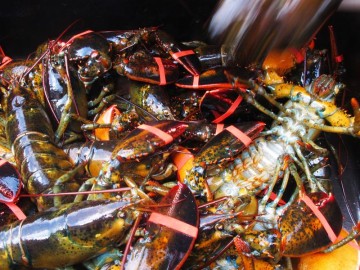 P.E.I. lobster fishermen are getting about $1 more a pound this year than they did at this time last year. They are getting $5 a pound for canners and $5.75 for market lobsters. Craig Avery, president of the P.E.I. Fishermen’s Association, has heard rumours some fishermen are getting as much as $6 a pound for markets. On Wednesday, grocery stores in Charlottetown were selling live market lobsters from between $9 and $11 a pound. Lower catches and increased demand have driven the price up, he said. Much of the demand is coming from Asia and Europe. Avery credits fishermen, processors and government officials for working hard to promote Island lobster. Link 09:35
P.E.I. lobster fishermen are getting about $1 more a pound this year than they did at this time last year. They are getting $5 a pound for canners and $5.75 for market lobsters. Craig Avery, president of the P.E.I. Fishermen’s Association, has heard rumours some fishermen are getting as much as $6 a pound for markets. On Wednesday, grocery stores in Charlottetown were selling live market lobsters from between $9 and $11 a pound. Lower catches and increased demand have driven the price up, he said. Much of the demand is coming from Asia and Europe. Avery credits fishermen, processors and government officials for working hard to promote Island lobster. Link 09:35
Department of Fisheries and Oceans: Northern cod biomass at highest rate since 1992
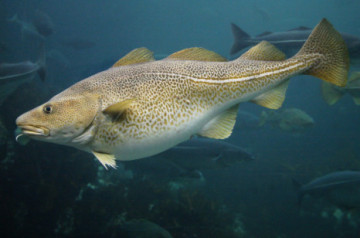 The Atlantic cod stocks are returning, but there’s still a long way to go before a large-scale commercial fishery becomes viable again. That’s the finding of new research by the Department of Fisheries and Oceans, which shows that cod stocks in the Northern region are on the way towards leaving the “critical” designation. The stock in the 2J, 3K and 3L regions has increased to an estimated 538,000 tons of fish — the highest rate since 1992. Still, the stock only reaches 34 per cent of the level needed to escape the “critical” zone. DFO performs stock assessments every three years, sourcing information from vessel surveys, commercial catches, tags on the cod and more. In 2013, the stock reached about 300,000 tons in biomass. Today, it’s almost double that. Read the story here 08:23
The Atlantic cod stocks are returning, but there’s still a long way to go before a large-scale commercial fishery becomes viable again. That’s the finding of new research by the Department of Fisheries and Oceans, which shows that cod stocks in the Northern region are on the way towards leaving the “critical” designation. The stock in the 2J, 3K and 3L regions has increased to an estimated 538,000 tons of fish — the highest rate since 1992. Still, the stock only reaches 34 per cent of the level needed to escape the “critical” zone. DFO performs stock assessments every three years, sourcing information from vessel surveys, commercial catches, tags on the cod and more. In 2013, the stock reached about 300,000 tons in biomass. Today, it’s almost double that. Read the story here 08:23

































